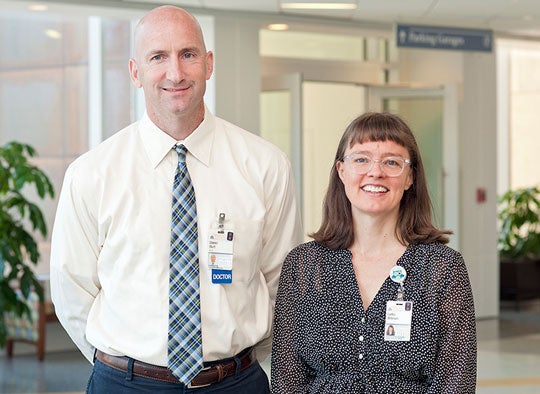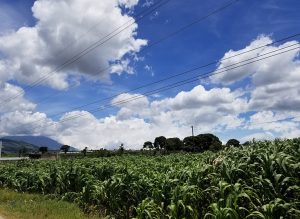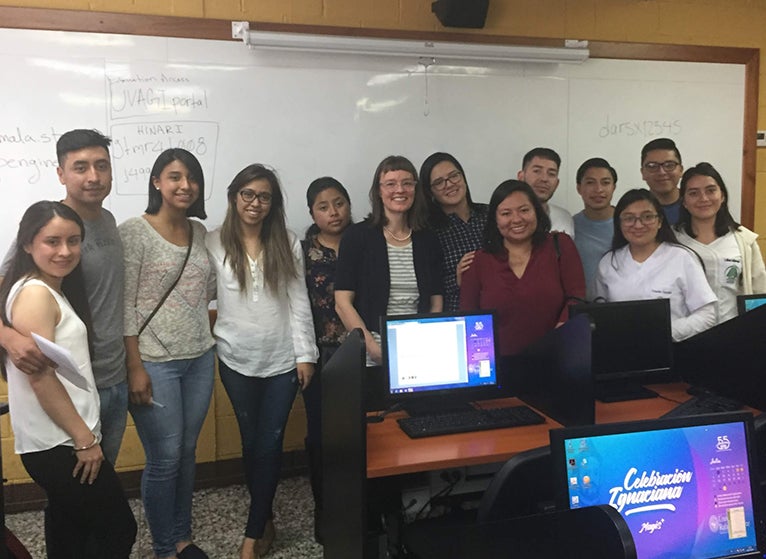In developing countries, hospitals like the one in Totonicapán, Guatemala, have brilliant doctors and nurses who desire to deliver the best care for their patients. And, while they do not have as much in the way of resources, it is not always the lack of tech that is the problem. Machines can be purchased or donated or found second-hand.
The biggest gap in providing excellent care is knowledge. With limited internet access, getting the most up-to-date medical information can be difficult.
This summer, with the help of the UVA-Guatemala Initiative (UVA-GI), all of that changed.
What is the UVA-Guatemala Initiative?
According to UVA-GI’s site, its mission is “to promote the development of mutually beneficial and sustainable relationships between UVA and the peoples and communities of Guatemala.” These relationships build a network that persists from project to project.
Over the past decade, UVA-GI has brought UVA students and faculty to Guatemala to work on projects that benefit the community in Guatemala. Partnership is the key here. Over time, the relationship with Guatemalan colleagues has developed into a series of collaborations.
Past projects from School of Medicine students and faculty from across Grounds include:
- Lake Atitlán Basin community, health and potable water collaboration: 400 families now have a biosand water filter in their homes. Each day, over 2,500 Guatemalans can drink clean water, free from fear of getting sick.
- Lake Atitlán Basin community: Providing cardiovascular health education and providing women access to reproductive health education. An important detail here is that the curricula is not taught in English or Spanish, but in Tz’tujil andKaqchiquel (respectively), native tongues to the region.
- Quetzaltenango (Xela)area: In partnership with the national hospital in Totonicapán, UVA-GI built, tested, and implemented an electronic medical record (EMR) platform in their emergency department. Additionally, UVA-GI started a training collaboration to bring emergency, point-of-care ultrasound to the hospital.
Jessica González, the in-country Director of UVA-GI says, “I co-founded this initiative with Dr. David Burt ten years ago, as a way to manage resources and access to those resources in Guatemala. UVA-GI facilitates that relationship, so that it doesn’t become a donor relation, but an actual partnership.”
In true patient-centered care, and in the spirit of meeting the patient where they are, all in-country UVA-GI staff are bilingual, covering the English, Spanish, Tz’tujil, Kaqchiquel, and K’iche’ languages. When UVA faculty, staff, and students join UVA-GI, they are educated on the social, cultural, and historical background of Guatemala. It makes the partnership work and shows “how we fit into the big picture,” says González.
Building a Network to Get on the Network
The most recent collaboration from UVA-GI was creating the Information Access Portal (IAP), a digital hub by which Guatemalan healthcare providers and students can gain access to the latest in academic health information such as treatments, procedures, protocols, research, and therapies. For physician faculty at Totonicapán Hospital, their access to this knowledge is now no different than if they were physically in Charlottesville, on-Grounds as UVA faculty, or sitting in our own Claude Moore Health Sciences Library.
How did we do it? David Burt, MD, Associate Professor of Emergency Medicine and Director of the UVA-Guatemala Initiative, says, “Originally, we partnered with the Center for Telehealth to deliver telemedicine-grade internet and video connectivity. Then, we heard from the physicians and staff that they had no access to medical literature. None. They asked if we would provide them access to the medical structure and literature of UVA — and we made that happen. The Information Access Portal is now live, as of July 2018.”
This new access affects healthcare in Totonicapán Hospital in a big way, as Burt explains. “When a doctor has a question about pediatric appendicitis, for example, he or she can go to a computer terminal and access Hinari, Up-To-Date, Lilacs, PubMed, or any of the resources that the UVA Health Sciences Library has to offer. And, what’s also great: If they have questions, they can email Lydia directly.”
The Lydia to whom Burt is referring is Lydia Witman, MLIS, Patient and Family Library Manager. Witman says that helping Guatemalan physicians in Totonicapán Hospital gain access to this medical information is critical for patient care “because the most current and valuable health information is digital, and it is largely accessible only through an online vendor or source.”
Dorian Rodríguez, UVA-GI’s IT/Project Coordinator, is in charge of tech support. “Before Lydia came, we installed a few computers in the hospital, but they didn’t have 24/7 access,” he says. “When Lydia got here, the physicians got engaged with the project. It was really important for the hospital to have this kind of access.”
Thirst for Knowledge is Universal
In development for a year, and tailored to Spanish-preferred end-users, IAP was developed thanks to a grant from Librarians Without Borders via the Medical Library Association and Hinari, a World Health Organization online program that enables low- and middle-income countries to gain access to one of the world’s largest collections of biomedical and health literature. The idea behind the grant was to deploy much-needed health information access in developing countries. This is exactly what IAP does.
Last year, faculty from Guatemala visited University of Virginia Health System. While here, they met with Witman to discuss IAP and work on a plan for her trip to Guatemala to launch the site. “I wanted to get a sense of what they had, and what I needed to provide in the training,” says Witman. “I asked them if they had access to a librarian? They said no. Access to texts books? ‘Not really — at the University we have some old texts and no librarian.’ Down there, students can’t take the books from the library.” For a librarian to hear this, it was heartbreaking. “That’s when I cried,” she says.
In late July of this year, Witman traveled to Guatemala to launch the IAP. “Once Telemedicine created the network, I was able to teach people how to access good information and how to filter that data for quality.”
Via a mix of English and Spanish, and with the help of in-country staff translators, Witman taught seminars at three different skill levels (beginner, intermediate, advanced) just as if she were teaching at UVA.“The knowledge need was exactly the same as here. The questions were the same. ‘How can I get the full text of this article?’ ‘How can I download this as a PDF?’ When teaching how to access information, needing to know these things seems universal. And they were hungry to get to the good information, to find the best and most efficient way to gain access to this wealth of information.”
The IAP is getting a good workout. Since its launch in late July, Witman and Burt have received many emails from healthcare providers in Totonicapán recounting how doctors and students are putting it to good use. Hundreds of copies of articles printed. Gigabits of data downloaded. In short: success.
When asked about her favorite part of the trip, Witman said, “The people were so kind and genuinely warm. The work was very rewarding. And the clothes — the native weave is so beautiful. The visual of the women in their traditional clothes is something I’ll never forget.”
Rodríguez says, “This new project with Lydia has been interesting, because many of the physicians are getting savvy on the tech stuff. I think they are more excited about learning than the common medical student. Having this access to articles makes their job easier.”
What’s in it for Us?
UVA-GI mission describes a “mutually beneficial” relationship. So … what’s in it for UVA?
It’s simple: Better care for our own patients here in Charlottesville.
Burt explains that when our faculty, staff, and students visit Guatemala, we put them through a service-language-culture template. “We ask our folks to study the Spanish language and they receive cultural orientation, so they have some basic skills before they move on to their project or patient care. … Medical schools teach cultural capacity, but not necessarily cultural understanding. It’s all intellectual without experience-based context.”
“If a student is in the ED, and a Latino family comes in, the student may not have the cultural understanding or the Spanish skillset to initiate a conversation. If not, then they are not a very good medical provider for that encounter with that family. By giving faculty, residents, and students an opportunity to go to Guatemala — where they have to learn Spanish and have to receive a cultural education — then the next time they examine a Latino patient, they can say, “Sientense, por favor. Me llamo David. Soy estudiante de medicina. Hablo un poquito de Espanol.” That language skill, paired with a cultural connection, allows for much better patient care.
“In visiting Guatemala, our team members learn humility,” says Burt. Mutualism creates a true partnership. “It gives us the opportunity to slow down and learn the language and the culture and really listen to the needs of our partners. And, ultimately, it makes us better doctors who can provide better patient care.”
The IAP could not have been built without collaboration among UVA-GI, the Center for Telehealth, the Department of Emergency Medicine, the Claude Moore Health Sciences Library, the Center for Global Health, the Center for Undergraduate Excellence, and of course, our Guatemalan friends and colleagues. All play an important part in ensuring all patients, in Guatemala or the United States, get the best care possible.
Filed Under: Media Highlights, Student





Comments